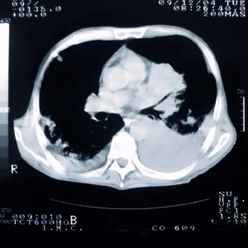Trends in Lung Cancer Incidence
Overall lung cancer rates have declined in the United States, but a new study shows how certain subtypes and demographic groups have more complicated trajectories.
Lung cancer on CT scan.

Lung cancer rates overall have declined significantly in the United States in recent years, but a new study shows how certain histologic subtypes have more complicated trajectories, as do specific demographic groups.
“Lung carcinoma rates remain higher among males than females, although rates have been converging and there are emerging excesses of adenocarcinoma and other specific carcinomas among young women,” wrote study authors led by Denise R. Lewis, PhD, MPH, of the National Cancer Institute in Bethesda, Maryland. The researchers analyzed data from the Surveillance, Epidemiology, and End Results (SEER) database to find trends in lung cancer rates between 1977 and 2010 in white and black individuals, and between 1992 and 2010 for white non-Hispanics, Asian/Pacific Islanders, and white Hispanics.
The study included a total of 452,714 cases of lung cancer. The incidence rate peaked in the early 1990s, and then declined consistently through 2010. Adenocarcinomas rose through the 1990s and peaked at more than 20 cases per 100,000 person-years before declining through 2004; after that rates actually began to rise again. Large-cell lung cancer rates have dropped dramatically since a peak around 1990, small-cell rates have fallen as well, and squamous cell carcinoma stabilized between 2006 and 2010 at 11 cases per 100,000 person-years.
To analyze rates among demographic groups another 86,768 cases from other registries were added to the cohort. Among males only, the overall lung carcinoma incidence peaked in the mid-1980s; it declined to 62 per 100,000 person-years among whites by 2010, and to 86 per 100,000 person-years among blacks. The rates among Asian/Pacific Islanders and Hispanics were “considerably lower” but also declined over that period.
“Among females, total lung cancer rates among whites and blacks rose steadily until stabilizing in recent years,” the authors wrote, adding that the other ethnic groups didn’t see much change since the 1990s. Decreases among males have been more pronounced, meaning that the male and female rates have been converging. The male/female ratio among whites was 2.95 from 1977 to 1981, and only 1.29 from 2006 to 2010. Those ratios among blacks were 3.94 and 1.71. The rates also converged specifically for squamous cell carcinoma, small-cell carcinoma, and other histologic subtypes. The authors noted that sex parity seems to be approaching, with some ratios closing in on 1 among whites in particular.
“A new finding is that decreases in squamous and small-cell carcinoma have been fairly parallel among male and female Asian/[Pacific islanders] and Hispanics, in contrast to converging rates among whites and blacks,” they wrote, adding that the continued climbing of adenocarcinoma rates among females is also important.
“These findings will require renewed clinical awareness and surveillance,” the researchers concluded. “The advances in determination of histologic type and molecular targeted therapy will hopefully improve patient survival.”